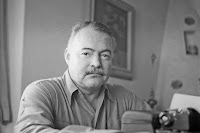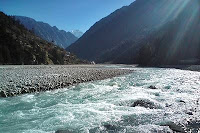P - 110(A) Assignment
Topic: Theatre Of The Absurd
Name: Nidhi Dave
Paper- History of English literature from 1900 to 2000.
Roll no- 16
Enrollment no- 4069206420210005
Email ID - davenidhi05@gmail.com
Batch-2021-23(MA Sem-2)
Submitted to- S. B. Gardi Department of English. Maharaja Krishnakumarsinhji Bhavnagar University.
👉Introduction:
The Theatre of the Absurd is a movement made up of many diverse plays, most of which were written between 1940 and 1960. When first performed, these plays shocked their audiences as they were startlingly different than anything that had been previously staged. In fact, many of them were labelled as “anti-plays.” In an attempt to clarify and define this radical movement, Martin Esslin coined the term “The Theatre of the Absurd” in his 1960 book of the same name. He defined it as such, because all of the plays emphasized the absurdity of the human condition. Whereas we tend to use the word “absurd” synonymously with “ridiculous,” Esslin was referring to the original meaning of the word– ‘out of harmony with reason or propriety; illogical’ (Esslin 23). Essentially, each play renders man’s existence as illogical, and moreover, meaningless. This idea was a reaction to the “collapse of moral, religious, political, and social structures” following the two World Wars of the Twentieth Century (Abbotson 1).
👉What is Theatre of the Absurd?
The Theatre of the Absurd is a term coined by Critic Martin Esslin in his essay “Theatre of the Absurd.” The term is used for the work of a number of playwrights, mostly written in the 1950s and 1960s, which were written by a number of primarily European playwrights in the late 1950s. Their work simply expressed the thought of human existence that has no meaning or purpose. If a trouble comes, some logic is given on a matter, it simply makes the situation worse and further leads to silence.
👉Theatre of the Absurd Definition
👉Merriam-Webster Dictionary defines the term as
👉"Theater that seeks to represent the absurdity of human existence in a meaningless universe by bizarre or fantastic means."
⭐Theatre of The Absurd History
This movement influenced by existentialism, began in the form of experimental theater in Paris and resultantly, after the spread of the absurd form in other country, absurdist plays were written in French. Absurd elements first came into existence after the rise of Greek drama in the plays of Aristophanes in the form of wild humor and buffoonery of old comedy.
Then, morality plays of the Middle Ages can also be called a precursor of the Theatre of the Absurd dealing with common man’s struggle with allegorical and existential problems. During Elizabethan period, dramatists like John Webster, Cyril Tourneur, Jakob Biederman and Calderon pictured the world as mythological archetype.
In 19th century, Ibsen and Strindberg also included some elements of absurd theater in their plays, but real precursor of the present Theater of Absurd is Alfred Jerry‘s monstrous puppet play Ubu Roi (1896). A glimpse of Theater of Absurd can be seen in the dream novels of James Joyce, Franz Kafka who created archetype by delving deep into their own consciousness and attempting to explore the universe.
World War II finally brought the Theater of Absurd to life because the chaotic atmosphere during that time was compelling them to think about their absurd existence.
👉Theatre of the Absurd Examples
Theater of absurd illustrates the philosophy of Albert Camus in The Myth of Sysiphus that speaks of life with no inherent meaning in it. For him, world was beyond the understanding of man, so it will always remain absurd and we should accept this fact. Martin Esslin considered four playwrights: Samuel Beckett, Eugene Ionesco, Arthur Adamov and Jean Genet as leaders of the movement. After sometimes, Harold Pinter was also included to this group and some of the works of Tom Stoppard, Edward Albee and Jean Tardieu were also classified as belonging to Absurdist Theater. But strangely, these writers were not always comfortable with the label and sometimes preferred to use terms such as “Anti-Theater” or “New Theater“.
Besides these, other playwrights like Tom Stoppard, Arthur Kopit, Friedrich Durrenmatt, Fernando Arrabal, Edward
⭐Theatre of the Absurd Characteristics
Following are the chief characteristics of the Theater of Absurd, but it must be noted here that all these characteristics cannot necessarily be found in all the absurdist plays because it is not necessary that the playwright must have used all the characteristics of Absurd plays:
👉Questions of Existence
Absurd plays raise some basic questions of existence like- why we are alive why we have to die and why there is injustice and suffering.
👉Distrust in Language
For absurdist playwrights, language is only a meaningless communication and stereotyped exchange of ideas because words fail to express essence of human existence.
👉Illogical Speeches and Meaningless Plots
By illogical speeches and meaningless plots, they wish to establish a feeling of freedom to make their own worlds. Dr. Culik says,
“Rationalist thought, like language, only deals with the superficial aspects of things, Nonsense, on the other hand, opens up a glimpse of the infinite.”
👉Re-establishment of man’s communion with Universe
They attempt to restore the importance of myth and rituals in the life of man and make them aware of the ultimate realities of their life.
👉Emphasize on Abstract Values of Life
Absurdists force us to look at our abstract values of life like love and family. Thus, we may hope to accept the absurdity of life and try to find values in a world devoid of them.
👉Vagueness about Time, Place and Character
Absurdists have no time, place and character in their plays as they feel that there is no past or future, only the repetition of the present
👉Lack of communication amid characters
Each character lives an egoistic life and attempts to get another character to understand him and this results in more alienation.
⭐Characters in Theater of the Absurd
Characters in the Theater of Absurd range from one-dimension to multi-dimensions and without feeling but still with a very sensitive feeling. Most of the characters are floating, stereotype, archetype and flat because they have to deal with the absurd universe and often discard rational and logical devices. The characters speak in clichés and realism is their chief basis but often they are distorted at many points.
Complex characters cannot go with this theater because ultimately they have to deal with incomprehensive universe. Characters in Pinter’s plays are trapped in an enclosed space menaced by some force and that force is incomprehensible to them. For example, In The Room, Rose, the main character is menaced by Riley where the real source of menace remains a mystery.
The characters in Absurd Drama face the chaos of a world that science and logic have abandoned completely. They find themselves trapped in a routine or, in a metafictional conceit, trapped in a story. For example, the titular characters in Tom Stoppard’s Rosencrantz & Guildenstern Are Dead, find themselves in a story (Hamlet) in which the outcome has already been decided.
The absurdists form their characters in interdependent pairs, often either two males or a male and a female. Beckett scholars term it as “pseudo couple” They may be outwardly equal or have a begrudging interdependence (like Vladimir and Estragon in Waiting for Godot). Here, one active character may dominate the other passive characters in the play and the relationship of characters also shift dramatically.
⭐Plot
Theater of Absurd discards the traditional pattern of plot construction. It consists of repetition of clichés and routine as in Waiting for Godot. There is always a menacing outside force that remains a mystery throughout the play. Absence, emptiness, nothingness, and unresolved mysteries are central features of many Absurdist plots.
⭐Features of Absurdist Plot
Absence
Emptiness
Nothingness
Unresolved
Mysteries
For example, the action in Waiting for Godot centers round the absence of a character Godot who is long awaited. The plot also revolves round unexplained metamorphosis, a shift in the laws of physics, or a supernatural change. For example, in Ionesco’s How to Get Rid of It, a couple is dealing with a corpse that is growing large steadily, but Ionesco never discloses the identity of the corpse and ultimately, the corpse floats away unidentified in the unknown. The plots are frequently cyclical too as occurs in Endgame, the play begins where it ends and the theme of routine and repetition keeps on moving.
⭐Language
Although, absurd plays bear nonsensical language and clichés, they are naturalistic to a great extent. It happens because words lose their denotative function and create misunderstanding among characters that make Theater of Absurd quite distinct. Sometimes, nonsense is used abusively as Pinter did in Birthday Party. Their language is sometimes adorned with phonetic, rhythmical, almost musical qualities that further lead to comedy in absurdity. The dialogues are made elliptical with a certain purpose. Most of the Backett’s plays do not value language for creating striking tableau. Pinter pause’ used by Harold Pinter presents elliptical dialogue and often primary things which a character should convey are replaced by ellipsis or dashes.
⭐Technique
The techniques these absurdists use are meta-theatrical techniques which explore role fulfillment, fate, and the theatricality of theatre. For example, in The Balcony, brothel patrons take up elevated positions in role-playing games, but the line between theatre and reality starts to blur. Rosencrantz & Guildenstern Are Dead is yet another example where two minor characters of Hamlet are major role players who encounter with actors who performed ‘Mousetrap in Hamlet. Thus, the techniques of illustrating the theme are so new that people are often confused at the time of production of some of these plays.
⭐Theatre of the Absurd Plays
The first large major production of an absurdist play was Jean Genet’s The Maids in 1947. Ionesco’s The Bald Soprana was first performed in 1950, and Samuel Beckett’s Waiting for Gadot is probably the best known of all absurdist plays and it was premiered in January 1953. Waiting for Godot is the most controversial absurdist play.Rest of the Absurdist plays are:
- Samuel Beckett: Waiting for Godot
- Eugene lonesco: The Bald soprano
- Jean Genet: The Balcony
- Slawomir Mrozek: Tango
- Harold Pinter: The Dumb Waiter and The Birthday Party
⭐Conclusion
Thus, The Absurd Theatre is not a positive play as it never tries to prove that man can still live in the futile world. It only demonstrates the absurdity and illogicality of the world in which we live but does not provide any solution to the problem. By these play, man is again and again reminded that his existence in the world is in fact absurd and meaningless. The countdown of The Absurd Theatre began in the mid-1960s. Although it shocked the audiences when it first appeared, many of its characteristic features were transferred in mainstream theatre when the Theater of Absurd ended. Those techniques are now commonly being used in modern theatre
Words: 1,785
Reference
https://sites.udel.edu/britlitwiki/the-theatre-of-the-absurd/
https://blisty.cz/video/Slavonic/Absurd.htm
https://www.eng-literature.com/2021/05/theatre-of-the-absurd-definition-examples-characteristics.html










_(14596966327).jpg)










